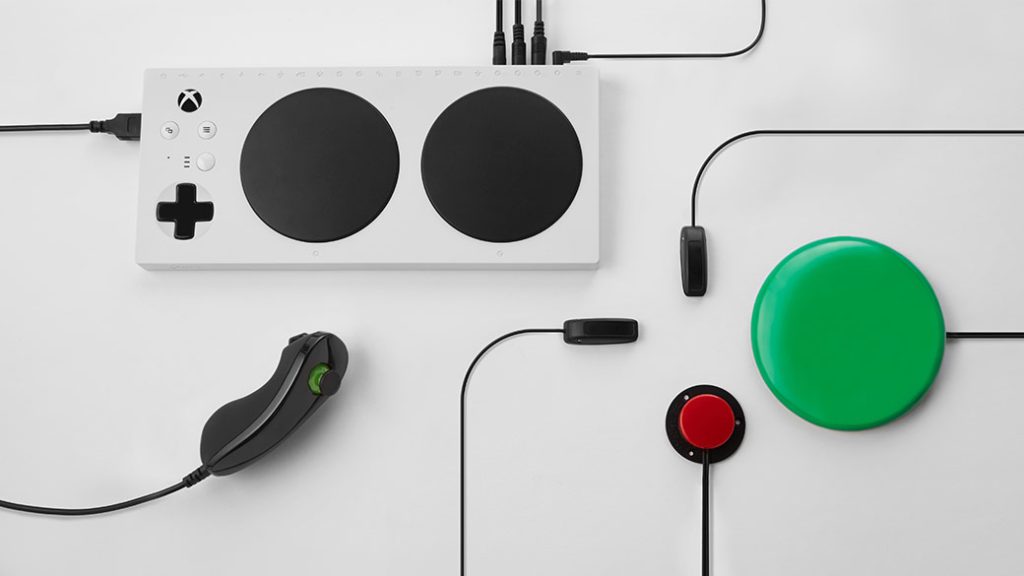Introduction:
The Xbox Adaptive Controller is a groundbreaking device developed by Microsoft to make gaming more accessible to individuals with limited mobility. First conceptualized in an internal hackathon in 2014, the device underwent several adaptations before its final release to the public in 2018. Designed with extensive input from gamers with disabilities and advocacy organizations, the controller features large programmable buttons, multiple ports for external switches and peripherals, and customizable settings to accommodate a wide range of needs and preferences.
Historically, gamers with disabilities often faced significant barriers to play video games due to limited mobility or dexterity. Just in the United states, AbleGamers estimates that the gamers with disabilities community is more than 30 million strong and therefore a sizable community to design for.
Our goal was to make the device as adaptable as possible, so gamers can create a setup that works for them in a way that is plug-and-play, extensible, and affordable.
-Microsoft Wire (Official publication) 2018
Models of disability framework:
The Xbox Adaptive Controller reflects a shift from the traditional medical model of disability, which views disability as a deficiency within the individual, to a more inclusive and empowering social model of disability. According to the social model, disability is not solely a result of an individual’s impairment but is also influenced by societal barriers and attitudes. By providing a tool that enables individuals with disabilities to participate fully in gaming, the Xbox Adaptive Controller challenges the notion of disability as a limitation and instead emphasizes the importance of inclusive design and accessibility.
The Xbox Adaptive Controller also embodies the principles of the functional solutions model of disability in its approach. It seeks to address the physical limitations of users through a technologically-driven, results-oriented solution, which is central to the framework of the functional solutions model. Through its innovative design, the controller enables gamers with disabilities to not only overcome obstacles but also enhances convenience and flexibility by offering multiple input modes tailored to the individual user’s needs. In my personal opinion, providing choices and therefore autonomy to the user is an extremely important objective in accessible design.
How does it work?
Instead of a traditional controller layout, it features large programmable buttons and a multitude of ports for connecting external switches, buttons, joysticks, and other accessories.
Some of the most common types of devices that are typically used with the Xbox Adaptive Controller:
- External Switches: External switches are one of the most common types of devices used with the XAC. These switches can be simple buttons or pads that users can press or activate using various body parts, such as hands, feet, or even head switches for individuals with limited mobility.
- Foot Pedals: Foot pedals are another popular option for users who may have limited hand mobility or prefer using their feet for certain controls.
- Joysticks and Thumbsticks: Joysticks and thumbsticks provide analog control input, allowing users to control movement and camera angles with precision. These devices can be particularly useful for users who require fine motor control adjustments or prefer the tactile feedback provided by analog sticks.
- Sip-and-Puff Devices: Sip-and-puff devices enable users to control the XAC by inhaling (sipping) or exhaling (puffing) into a tube. By varying the intensity and duration of sips and puffs, users can trigger different commands and actions in games, providing a hands-free control option for individuals with severe mobility impairments.
- Touchpads and Trackballs: These devices allow users to control on-screen cursor movements or perform gestures by sliding their fingers or palms across a touch-sensitive surface or rotating a trackball.
- Button Boxes and Panels: Button boxes and panels feature an array of buttons, switches, and other input controls arranged in a compact layout. These devices provide users with a centralized control interface for accessing a wide range of commands and functions without the need for multiple individual switches or devices.

Drawbacks and concerns:
While the Xbox Adaptive Controller represents a significant step towards a more inclusive gaming future, it does face limitations and accessibility concerns. Priced between $100 and $130, in addition to the cost of the Xbox One console itself (ranging from $380 to $650), it remains out of reach for many potential users. Furthermore, the external devices required to complement the adaptive controller are often prohibitively expensive, with popular switches and buttons retailing for upwards of $75 each.
One potential solution could be for Xbox to offer the adaptive controller as a replacement option for the standard controller upon request, thereby eliminating the need for users to purchase it separately.
In conclusion, there is a notable shift in the gaming industry towards greater consideration of accessibility. Beyond hardware improvements, game designers and related companies are increasingly recognizing the importance of incorporating accessibility requirements from game conceptualization itself, thereby striving to make games more inclusive and accommodating to a diverse range of players.
References:
Xbox, P. S. H. O. (2018, November 13). Accessible Gaming with the Xbox Adaptive Controller – Xbox Wire. Xbox Wire. https://news.xbox.com/en-us/2018/05/16/xbox-adaptive-controller/
Plugged in | Microsoft Story Labs. (n.d.). Plugged in | Microsoft Story Labs. https://news.microsoft.com/stories/xbox-adaptive-controller/
Joe Skrebels, Xbox Wire Editor-in-Chief. (2023, October 18). Xbox Continues to Champion the Gaming & Disability Community with New Accessibility Updates – Xbox Wire. Xbox Wire. https://news.xbox.com/en-us/2023/10/17/xbox-new-accessibility-updates/
